One of the most unique mausoleum works in Hue citadel is Gia Long Tomb. Although located in a remote mountain area, this is still a place that attracts tourists to learn about historical works and idyllic natural landscapes. Let’s follow DanangPrivateCar.com’s to discover more about the mysterious story around Gia Long Tomb !
About Gia Long Tomb of Hue
Hue Citadel is famous for its system of mausoleums and temples, but perhaps the most unique is the mausoleums of the Nguyen kings. During the history of 1802 – 1945, through 13 Nguyen kings, Hue left a group of spiritual relics quiet and full of mystery. Gia Long Tomb is a unique highlight in both historical significance and cultural architecture.
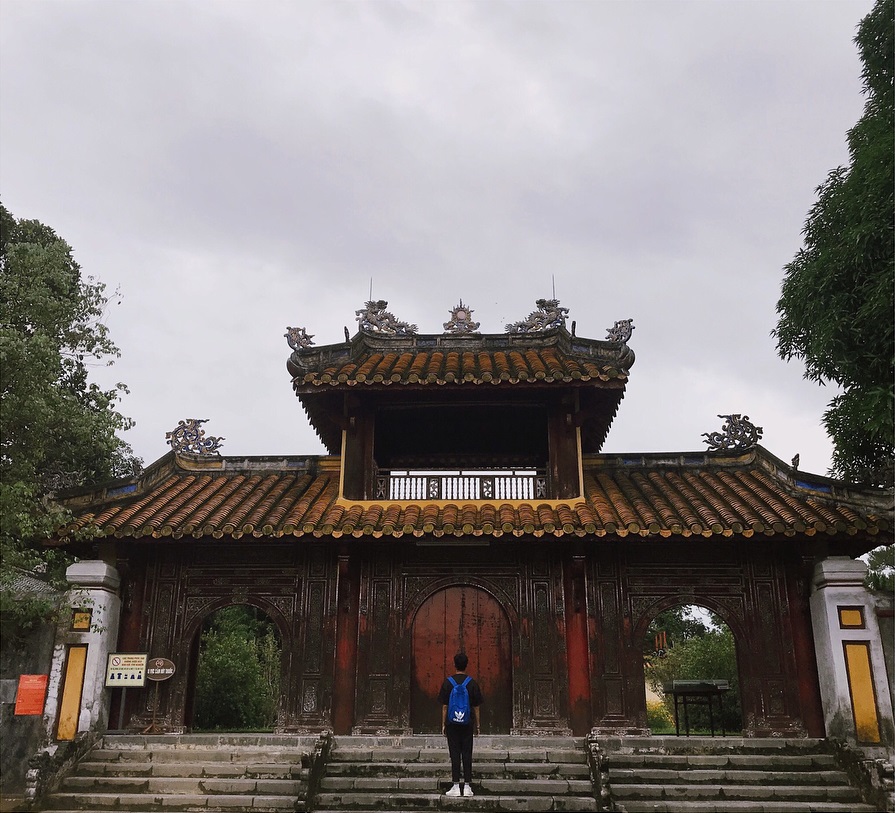
Gia Long Tomb was built on the remote and desolate Thien Tho Son mountain. It is said that this is a place chosen by Le Duy Thanh (son of Le Quy Don) because of geography, which has many astronomical and geographical meanings. The mountain area is surrounded by two streams of water bending on both sides, so the road to Gia Long Tomb is quite difficult. People still spread the word because King Gia Long regained his fortune from the Tay Son dynasty, so when he died, he was buried in a remote place, avoiding revenge.
If you are in Da Nang and want to visit Gia Long Tomb in Hue, you can book a day trip from Da Nang to Hue with DanangPrivateCar.com. Our one-day trip will take you through various attractions such as Hai Van Pass, Lap An Lagoon, Thien Mu Pagoda, Imperial City of Hue, and other tombs in Hue,… Additionally, you have the flexibility to add any other destinations you wish to visit to your itinerary.
Entrance Fee for Gia Long Tomb
The ticket prices for Gia Long Tomb are quite affordable and suitable for various visitors:
- For Vietnamese visitors: 50,000 VND per adult ticket, free for children.
- For international visitors: 100,000 VND per adult ticket, free for children.
Visitors can visit Gia Long Tomb from 7:00 AM to 5:30 PM, Monday to Friday
How to Get to Gia Long Tomb in Hue
Gia Long Tomb is located on Thien Tho Mountain, about 20 km from the city center, and is surrounded by rivers. Historically, this area was quite isolated, and visitors could only reach the tomb by boat. At that time, Gia Long Tomb was somewhat forgotten and received very few tourists.
In recent years, floating bridges have been constructed to accommodate pedestrians and motorized vehicles like bicycles and motorcycles, with a fee of 5,000 VND per crossing. These bridges not only serve a practical transportation purpose but also enhance the visitor experience by showcasing the scenic beauty of Gia Long Tomb. Once you cross the floating bridge, it’s approximately a 4 km journey to the tomb. This bridge has helped connect the local community and has increased the number of visitors to the site.
Aside from using the floating bridge, you can also travel via the Huu Trach Bridge, which connects La Khe Bai and La Khe Trem areas. However, please note that this route is longer, requiring an additional 10 km drive after crossing the bridge to reach the tomb.

If you plan to visit other sites such as Khai Dinh Tomb, the Hue Imperial City, or Thien Mu Pagoda, consider using a private car rental service with a driver in Hue. Our service offers pick-up and drop-off at your location, with English-speaking drivers to ensure a private and comfortable travel experience. You can book a Hue city tour by Private Car with DanangPrivateCar.com to enjoy the best of Hue with ease and convenience.
Fascinating Experiences When Visiting Gia Long Tomb
Exploring Significant Historical Events
Emperor Gia Long, born in 1762, was originally named Nguyen Phuc Anh. He was the first emperor to establish the Nguyen Dynasty, the last ruling dynasty in Vietnamese history. Despite his imposing and powerful image, few people know that he had a deep, unwavering love for Empress Thua Thien Cao.
Empress Thua Thien Cao was the daughter of Tong Phuoc Khuong, a prominent noble. She was known for her beauty, grace, and adherence to traditional virtues. She became the Empress at the age of 18 and stood by the emperor through many hardships.
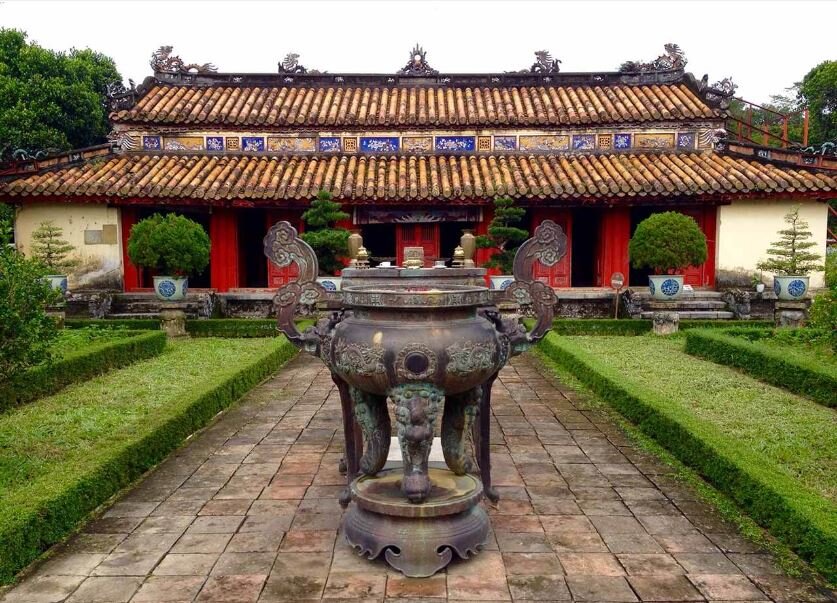
The romantic love story between the emperor and the empress has touched many hearts, especially the profound gestures Emperor Gia Long made for his wife. In 1814, he ordered the construction of a tomb beside the empress’s, ensuring that he would rest eternally beside the woman he loved.
During their lifetimes, the emperor and empress shared deep affection and endured many challenges together. Even after her passing, the emperor wished to remain by her side forever. This enduring love is one of the reasons why Gia Long Tomb stands out as a unique and distinctive site compared to other royal tombs.
Admiring Unique Architectural Works
Visitors to Gia Long Tomb can explore its unique architecture, which is divided into three main sections:
- The tombs of the emperor and empress are at the center.
- On the right is Minh Thanh Shrine.
- On the left is the Bi Dinh Pavilion.
These three structures are situated on three small hills named Chinh Trung (center), Thanh Son (left), and Bach Son (right). Gia Long Tomb covers an area of 28 square kilometers and includes various auxiliary structures that showcase ancient beauty. Additionally, the tombs of several royal family members and the emperor are also located here.
Tomb Area – Buu Thanh
The central tomb area, Buu Thanh, houses the tombs of Emperor Gia Long and the Empress, placed side by side. The tombs are simply decorated, with no intricate carvings, and are positioned just a hand’s width apart.
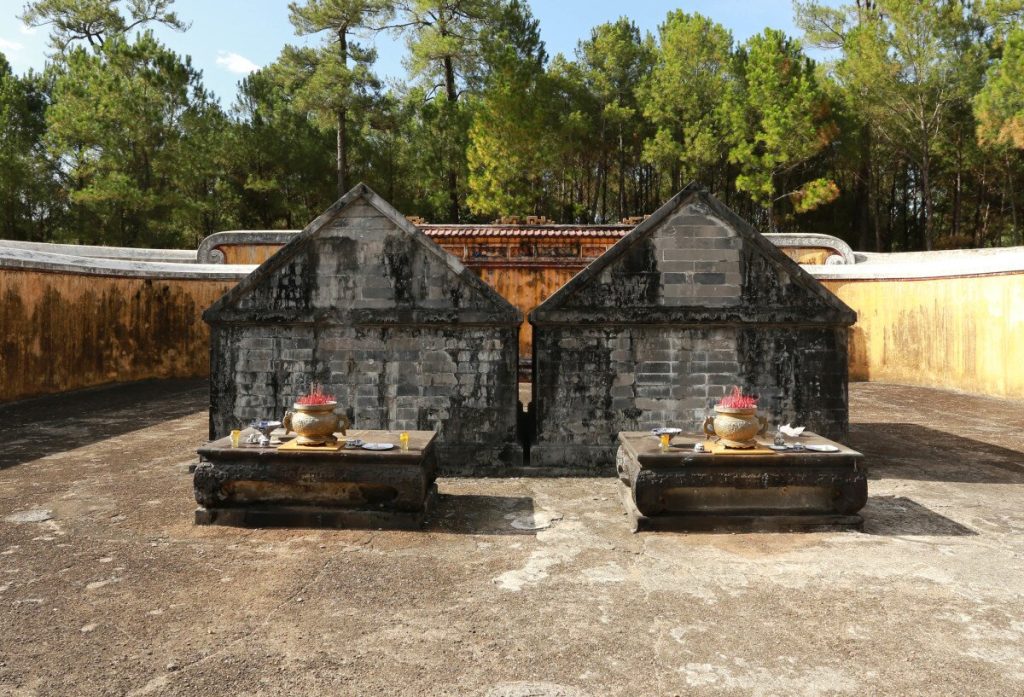
From behind the tombs, visitors can view Dai Thien Tho Mountain, one of the largest mountains in the area, right above the tombs’ roof. This unique feng shui feature is a distinctive aspect of Gia Long Tomb.
Surrounding Gia Long Tomb is a solidly built wall known as Buu Thanh. The main gate leading into the tomb area is made of bronze and is typically only opened on special occasions such as festivals or commemorative days.
Bi Dinh – Stele Pavilion
Located to the left of the tomb area is Bi Dinh, the Stele Pavilion, which honors the scholars of the time. This structure is a common feature found in most Nguyen Dynasty tombs.

Inside Bi Dinh is the “Thanh Duc Than Cong” stele, erected by Emperor Minh Mang to praise Emperor Gia Long, the first ruler of the Nguyen Dynasty. The stele is intricately carved, and despite being nearly two centuries old, the inscriptions remain well-preserved.
Minh Thanh Shrine
Located at the center-right is the Minh Thanh Shrine, where offerings are made, and incense is burned for the emperor and empress. The shrine also houses many artifacts from Emperor Gia Long‘s life, although some have been lost or damaged over time.

In addition to Thien Tho Tomb, Hue is also home to other tombs of Nguyen Dynasty emperors, such as Minh Mang, Khai Dinh, Tu Duc, and Vinh Mau Tombs.
Thien Tho Huu Tomb and Gia Thanh Shrine
Thien Tho Huu Tomb and Gia Thanh Shrine are where Emperor Gia Long‘s second wife, and the mother of Emperor Minh Mang, is buried. This area attracts many visitors due to its harmonious and poetic natural scenery.
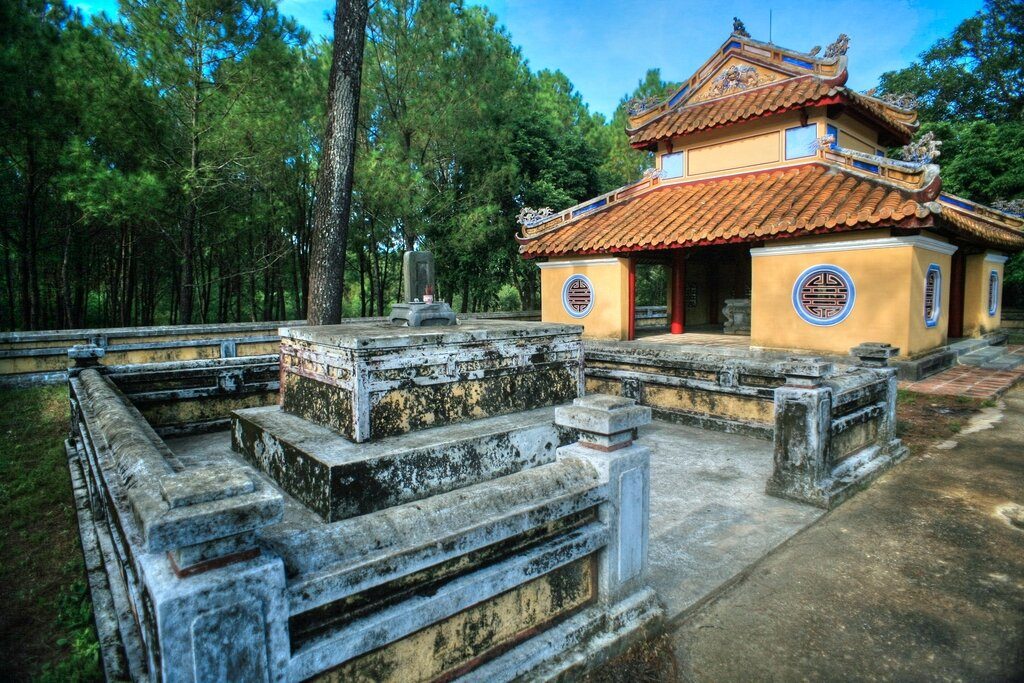
Immersing in the Tranquil, Ancient Atmosphere
Gia Long Tomb is situated upstream of the Perfume River, surrounded by lush green hills and sections of the primeval forest. This setting creates a serene, ancient atmosphere that is particularly appealing to visitors.
As you step into Gia Long Tomb, you’ll feel the solemn, peaceful, and tranquil ambiance. The structures, built from stone and ceramic tiles, feature a unique blend of architectural styles.
Beyond its impressive architecture, Gia Long Tomb is also home to many lush gardens and greenery, creating a healthy ecosystem for various birds and animals. Visitors can enjoy a leisurely stroll through the grounds, learn about the nation’s history and culture, and take in the beautiful scenery.

Tips for Visiting Gia Long Tomb in Hue
Gia Long Tomb in Hue is one of Vietnam’s most famous historical and cultural attractions. To ensure an enjoyable and fulfilling visit, here are a few things to keep in mind:
Dining Options
In the Gia Long Tomb area, you can find several restaurants and eateries offering Hue’s specialty dishes. Below are some recommended places to eat:
- Le Quyen Restaurant: 17 Le Thai To, Hue City, Thua Thien Hue
- Nhu Y Restaurant: 25 Nguyen Sinh Cung, Hue City, Thua Thien Hue
- Lac Thanh Eatery: 49 Le Quy Don, Hue City, Thua Thien Hue
- Cung Dinh Restaurant: 5 Dang Tran Con, Hue City, Thua Thien Hue
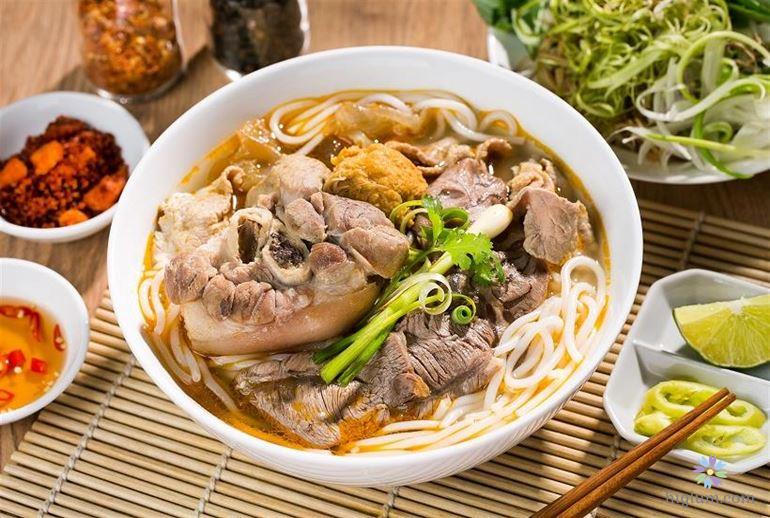
Recommended Hotels Near Gia Long Tomb in Hue
Based on my travel experience in Hue, selecting the right hotel is crucial for a restful and relaxing stay after a day of exploring. Here are the top 3 outstanding hotels:
- Beaulieu Boutique Hotel
- Address: 15 Pham Ngu Lao, Phu Hoi, Hue City, Thua Thien Hue
- Hotline for reservations: 0961.116.079
- Eva Homestay Hue
- Address: 14/10 Ben Nghe, Hue City, Thua Thien Hue
- Hotline: 0367.404.677
- Charming Riverside Hotel
- Address: 5/27 Nguyen Sinh Cung, Vy Da, Hue City, Thua Thien Hue
- Hotline for reservations: 0961.384.979
Best Time to Visit
The best time to visit Gia Long Tomb is from January to May each year. During this period, Hue’s weather is typically dry, not too sunny or rainy, and the climate is relatively cool. This is also the time of the Hue Spring Flower Festival, when the city is beautifully decorated with thousands of different flowers, and various cultural and artistic activities are held, attracting numerous tourists to explore and enjoy.
Read more detailed information about the best time to visit Hue: When is the Best Time to Visit Hue? Discover the Most Beautiful Season of the Year.
Nearby Attractions to Gia Long Tomb
In addition to visiting the historic Gia Long Tomb, Hue offers a rich array of nearby attractions that showcase the city’s cultural and historical significance. Here’s a guide to some must-see sites within a short distance:
- Tomb of Tu Duc: Located 14.4 km from Gia Long Tomb, this mausoleum is renowned for its beautiful architecture and serene setting. The tomb complex includes a picturesque lake and lush gardens, providing a peaceful retreat and a glimpse into the life of Emperor Tu Duc.
- Minh Mang Tomb: Situated just 7.3 km away, Minh Mang Tomb is a grand mausoleum surrounded by a stunning landscape of lakes and gardens. The site reflects the grandeur of the Nguyen Dynasty with its intricate designs and historical significance.

- Khai Dinh Tomb: At a distance of 10.3 km, this mausoleum stands out for its unique blend of Eastern and Western architectural styles. Khai Dinh Tomb features elaborate mosaics and impressive sculptures, making it a remarkable example of the artistic legacy of the Nguyen emperors.

- Hue Imperial Citadel: About 19 km from Gia Long Tomb, the Hue Imperial Citadel is a UNESCO World Heritage Site that offers a comprehensive view of Vietnam’s royal past. The citadel’s vast complex includes the Forbidden Purple City, palaces, temples, and extensive defensive walls.
- Hue National School: Located 17.8 km away, this historical institution was an important educational center during the Nguyen Dynasty. The school’s architecture and historical significance provide valuable insights into the educational reforms of the time.
- Nam Giao Esplanade: Approximately 15.5 km from Gia Long Tomb, Nam Giao Esplanade was a ceremonial site where emperors conducted important rituals. The site’s historical and cultural importance is reflected in its expansive layout and historical artifacts.
- Phu Cam Church: Situated 13.7 km away, Phu Cam Church is a notable religious landmark with its striking Gothic architecture. The church stands as a testament to the diverse cultural influences in Hue and offers a serene atmosphere for reflection.
- Hon Chen Palace: Located 17.1 km from Gia Long Tomb, Hon Chen Palace is a historic site with connections to local religious practices and ceremonies. The palace’s beautiful setting along the river adds to its charm and historical intrigue.
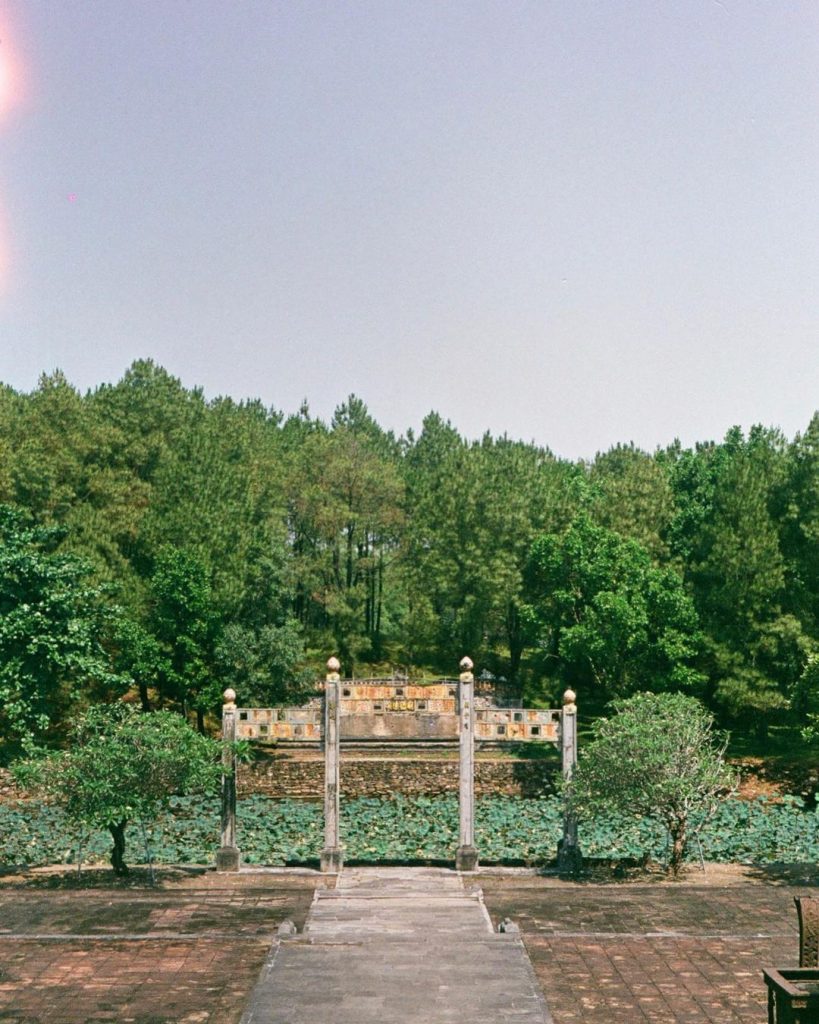
Important Notes When Visiting Gia Long Tomb in Hue
Gia Long Tomb in Hue is a place of historical significance and reverence. Please keep the following guidelines in mind:
- Dress Appropriately: Wear respectful clothing suitable for a historical site.
- Maintain Cleanliness: Avoid causing disturbances or littering.
- Respect Artifacts: Do not touch artifacts if signs indicate that it is prohibited.
- Honor Cultural Heritage: Show respect for the national culture and its beauty.
Conclusion
Gia Long Tomb is considered one of the most unique architectural marvels in Hue. When visiting Hue, tourists will find themselves immersed in the ancient, solemn atmosphere of this historic site nestled amidst the mountains and rivers of the ancient capital. The tomb not only preserves significant historical markers of Vietnam but also stands as a testament to the emperor’s unwavering and devoted love for his beloved. DanangPrivateCar.com wishes you and your family a memorable and enjoyable visit to Gia Long Tomb.

